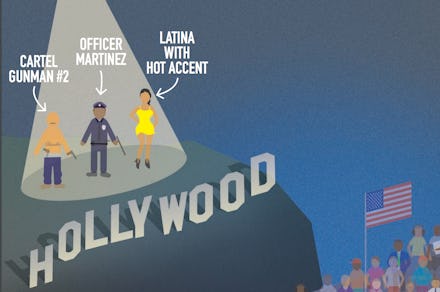Latino actors are still ignored when it comes to leading roles in film in 2016

The top 10 highest-grossing movies of 2016 share a few defining characteristics: talking animals, superheroes and almost no Latinos.
Of those films, only one Latino actor played a Latino character: Jay Hernandez as the stoic and spiritual Chato "El Diablo" Santana in Suicide Squad. Hernandez's character is one of several memorable supporting performances from Latino actors in 2016. Diego Luna in Star Wars: Rogue One and Gina Rodriguez in Deep Water Horizon also serve up some of the year's standout performances in heavy-hitter ensemble casts.
But silver screen diversity has a long way to go when it comes to Latino actors and actresses, who rarely get a shot to lead a major studio film. This flies in the face of logic. As demonstrated in the report "The Latino Media Gap," even as the Latino population rises, Latino names remain absent from the multiplex marquees. A 2013 study by the Motion Picture Association of America found that while Latinos make up 17% of the population, they accounted for 32% of moviegoers that year.
"It's still about checking off the diversity box," Felix Sanchez, chairman and co-founder of the National Hispanic Foundation for the Arts, said in a phone interview. "You can say, 'We had a multi-ethnic cast!' and feel some success about it, but [Latinos] are still playing on the margins."
A study from the University of Southern California found that, among 2014's top 100 highest-grossing films, 73.1% of characters whose races were divulged were white. In terms of speaking or named roles, Latinos came in fourth behind black characters (at 12.5%) and Asian characters (at 5.3%).
Why Latino representation remains so low on screen is a multifaceted problem. Executives and casting directors tend to stick to a risk-averse formula, which leaves little room to take chances on lesser known talent. This creates a vicious cycle: Latino stars don't get a chance to lead films because they don't have a proven track record, but they can't get a proven track record if they don't get the chance to lead a film.
"There's a sense [in Hollywood] that you build a pattern or a formula, and [Latinos] have never been a part of the pattern or the formula that spells success," Sanchez said.
Changing that formula is harder than just appealing to directors or casting agents. Latino directors who score gigs on high-profile projects often have to make films with "universal" appeal. Chilean director Pablo Larraín proved that to be true this year when he was able to get a gig directing the all-white film Jackie, a biopic of first lady Jackie Kennedy.
Studio heads aren't going to help much. A 2015 University of California, Los Angeles, study found that 94% of studio heads were white, and every single one of them was male. Senior management at studio was not much better: 92% were white and 83% were male. Casting agents may not move the diversity needly any further, either. A 2014 study found that three agencies represented the majority of the writing, acting, producing and directing talent in Hollywood — and their talent rosters were less than half as diverse as the remaining studios.
Even when parts call for Latino actors, Latinos may not be in the running. In 2011, director Nicolas Winding Refn cast Carey Mulligan as the female lead in his film Drive, even though the part was written as a Latina. If a Latino is casted, there's no guarantee that it will lead to more visibility. Oscar Isaac's face was caked with makeup and beyond recognizable in his role as Apocalypse in X-Men: Apocalypse, which was released in May.
Erasure from the media has negative social and political repercussions for U.S. Latinos. The 2014 report "The Latino Media Gap" emphasized that "the limited and stereotypical nature of existing stories ... sanctions hostility toward the country's largest minority."
"A lack of understanding of who we are creates fear," Sanchez said in an earlier interview with Mic.
More nuanced portrayals of Latinos are readily available to anyone who turns on their TV, laptop or favorite streaming device. Shows like Jane the Virgin, Mozart in the Jungle and Netflix's El Club de Cuervos are making strides in Latino representation, while actresses like America Ferrera in Superstore and Sofia Vergara are still putting Latina faces in crowded ensemble casts.
Television may have more nuanced portrayals of Latinos because the format allows for niche audiences, as opposed to films, which need broad appeal. Equitable Latino representation on film is still an admirable goal, and to accomplish it, Latinos have to share with studios — via tweets, emails and more — that the status quo is not enough.
"Until we demand more from the industry, they will continue to profit off of our viewership and provide very little reflection of who we are today," he said.